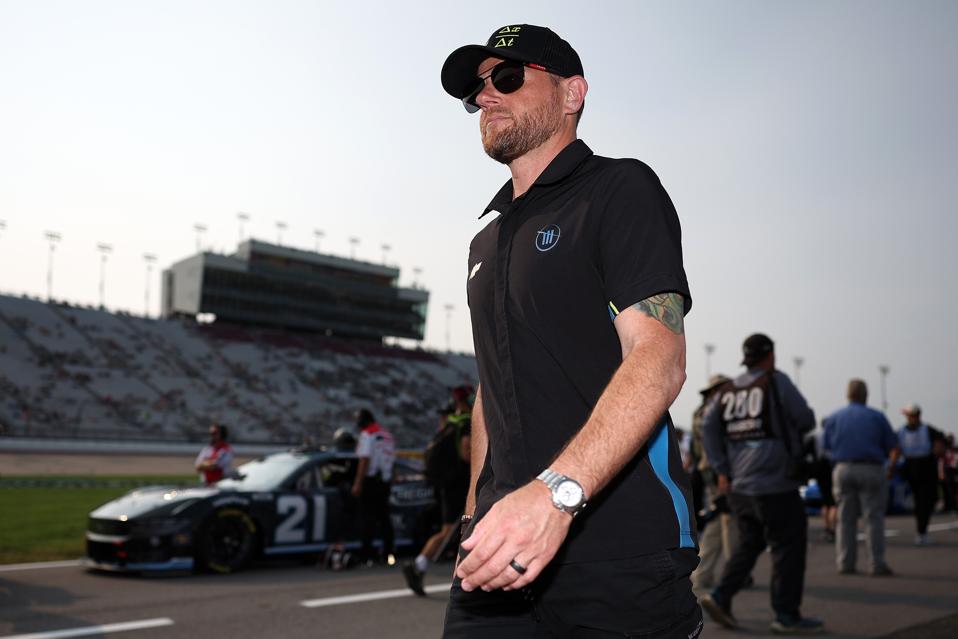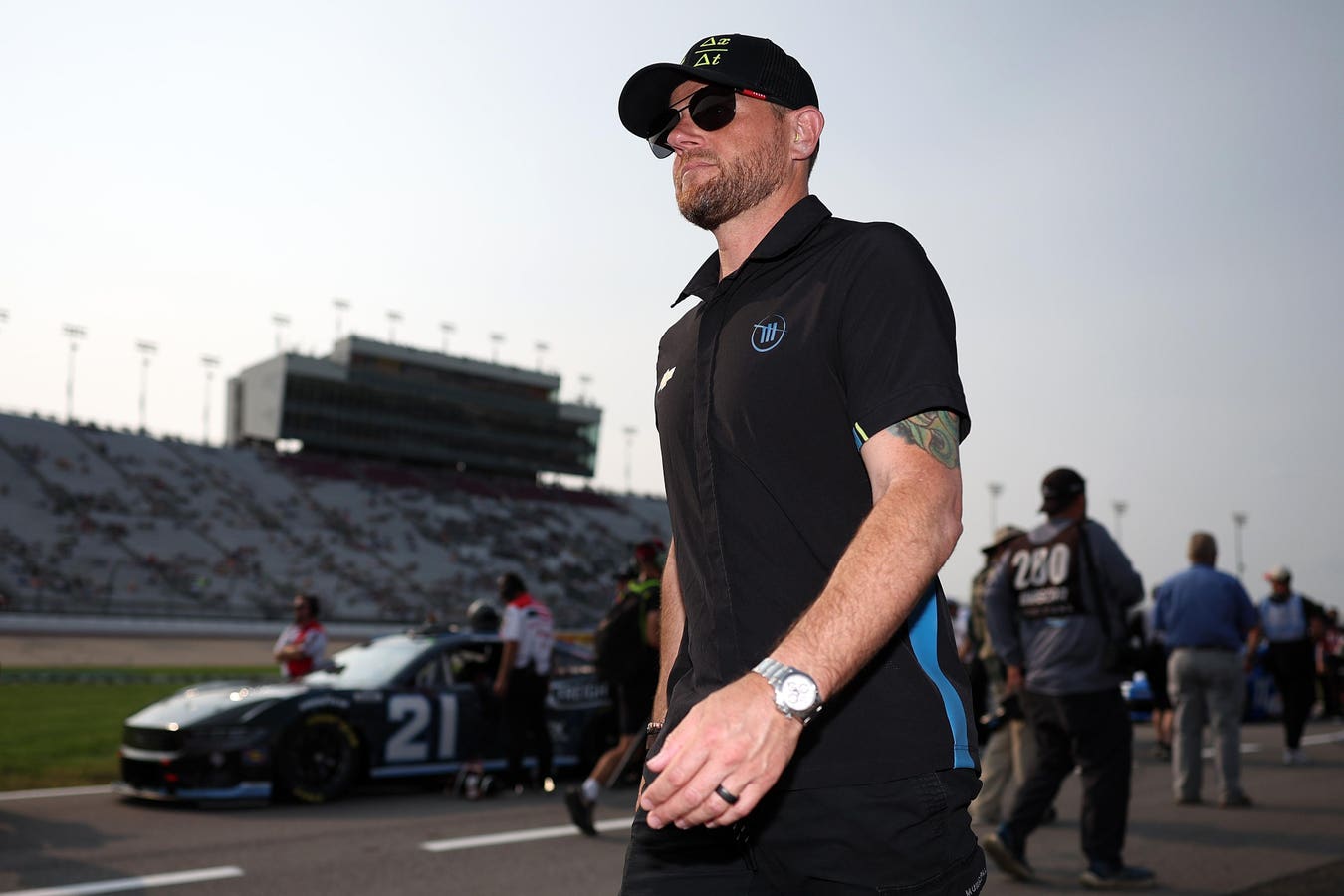
LEBANON, TENNESSEE – MAY 31: Trackhouse Racing team owner Justin Marks walks the grid during practice for the NASCAR Cup Series Cracker Barrel 400 at Nashville Superspeedway on May 31, 2025 in Lebanon, Tennessee. (Photo by James Gilbert/Getty Images)
Getty Images
When Trackhouse Racing burst onto the scene in 2021, it was a disruptor of sorts, a NASCAR version of a Silicon Valley startup. It had the swagger, the soundbites, and a Grammy winning co-owner whose sunglasses were almost as reflective as the paint on the car. For a while, the image worked. The team was fast, flashy, and fun to watch.
But something happened over the past year. The celebrity sheen has dimmed, and what’s left looks less like a startup and for next season more like a long-term operation built to last.
ForbesAn Unconventional Nascar Team Owner Finding Conventional Success In The SportBy Greg EngleForbesNascar Gains A ‘Worldwide’ Ambassador As Pitbull Becomes A Team OwnerBy Greg Engle
Pitbull ended his partnership with Trackhouse in February this year, closing a chapter that helped put the team on the cultural “Worldwide” map (pun very much intended). It was the kind of news that might have rattled most organizations. Instead, Trackhouse seemed to take it all in stride. The team’s founder, Justin Marks, didn’t panic or scramble for another famous face. Instead, he’s started building for the future, closing one chapter and starting another.
It’s a chapter that opens with the departure of their first-ever driver Daniel Suarez, a move that now seems almost like a turning point. Maybe it will be the moment they stopped experimenting and started engineering their future.
From Chaos to Continuity
Ross Chastain remains the lone anchor. The Florida watermelon farmer turned Cup Series winner has been with Trackhouse since its early days, named as its second fulltime driver in 2021. He’s been around long enough to see the team evolve from disruptor to playoff regular. He’ll continue to drive the No. 1 Chevy in 2026, and if the new structure is any indication, he’ll likely be there for a long while.
That’s because the team has made a significant investment, bringing in Brandon McSwain from Hendrick Motorsports to serve as crew chief for Chastain. McSwain, a fellow Florida native with a mechanical engineering degree from UNC Charlotte, helped lead William Byron’s No. 24 team to multiple wins over the past few seasons. For Trackhouse, that’s not just a hire; it’s a message. This team isn’t chasing short-term momentum anymore. It’s building engineering depth.
CONCORD, NORTH CAROLINA – MAY 25: Ross Chastain, driver of the #1 Jockey x Folds of Honor Chevrolet, celebrates in victory lane after winning the NASCAR Cup Series Coca-Cola 600 at Charlotte Motor Speedway on May 25, 2025 in Concord, North Carolina. (Photo by Jared C. Tilton/Getty Images)
Getty Images
“I worked with Brandon very early in my career,” Chastain said. “He’s someone I’ve kept my eye on for a while in case the chance to work together ever came to fruition. I’m looking forward to getting started.”
Chastain’s former crew chief, Phil Surgen, isn’t going anywher but has been moved to another role in the organization, one that after five years atop a pit box will keep him home most weekends. It’s a reshuffle that feels less like musical chairs and more like corporate restructuring. Everyone’s still in the building, but the desks have moved around to make the workflow better.
Shane van Gisbergen’s Legacy Ride
CONCORD, NORTH CAROLINA – OCTOBER 05: Shane Van Gisbergen, driver of the #88 WeatherTech Chevrolet, celebrates in victory lane after winning the NASCAR Cup Series Bank of America ROVAL 400 at Charlotte Motor Speedway on October 05, 2025 in Concord, North Carolina. (Photo by Jordan Bank/Getty Images)
Getty Images
Shane van Gisbergen will carry the No. 97 on his Chevy next season, a number steeped in family history. It was his father’s number when he raced in New Zealand and the same number Shane used during his dominant Supercars run that earned him three championships and 80 wins.
“It’s awesome to carry a car number that is so special to me,” van Gisbergen said. “My dad used it in his racing career, and I’ve used it in pretty much everything since. It’s cool to get the opportunity to create even more moments with it in the Cup Series.”
Van Gisbergen’s first full season in NASCAR was more than impressive. Five wins, including the Chicago Street Race and Sonoma, made him one of the most successful rookies the sport has ever seen. Stephen Doran, who guided him through that breakout campaign, will stay on as crew chief.
This pairing feels like another cornerstone being cemented. Trackhouse isn’t just finding talent. It’s keeping it.
The Future: Connor Zilisch and the No. 88
And then there’s Connor Zilisch, the 19-year-old who already looks like the next big thing. Zilisch will take over the No. 88 in 2026 after a dominant Xfinity Series season that included 10 wins and a Rookie of the Year title with JR Motorsports.
He’ll be paired with veteran crew chief Randall Burnett, who brings both Cup Series experience and a 2019 Xfinity championship with Tyler Reddick. That combination of youthful talent and steady leadership is a pattern now.
PORTLAND, OREGON – AUGUST 30: Connor Zilisch, driver of the #88 WeatherTech Chevrolet, celebrates in victory lane after winning the NASCAR Xfinity Series Pacific Office Automation 147 at Portland International Raceway on August 30, 2025 in Portland, Oregon. (Photo by David Jensen/Getty Images)
Getty Images
Marks isn’t just filling seats. He’s planning generations.
“It’s cool for me to carry on the legacy of the 88 number,” Zilisch said. “That number has quickly become important to me and the history of that number in the sport with Shane, Dale Jr., Dale Jarrett, and everyone who has run the 88. I certainly have big shoes to fill.”
The Marks Method
What Justin Marks has built in just five years would make most team owners dizzy. Fourteen wins, 57 top-fives, 113 top-tens, and four consecutive playoff appearances. But it’s not the stats that stand out; it’s the pace of evolution.
“There was an opportunity for the 2026 season to kind of reset everything,” Marks said. “We looked at the organization as a whole and see the 2026 season as the next iteration of Trackhouse. Ross, Shane, and Connor are all excited about who they’re working with next year. This is another big step in creating the Trackhouse legacy.”
That word, legacy, is the key here. Trackhouse started as a statement. Now it’s becoming an institution.
Where other teams shuffle lineups like cards in a casino, Marks has built a core of drivers who could conceivably grow old together. Chastain is the battle-hardened veteran. Van Gisbergen is the global star. Zilisch is the heir apparent. Each one represents a chapter in a story that feels like it’s only beginning.
It’s a far cry from the early days when the team was more known for its swagger than its stability. Back then, Trackhouse felt like a musical side project. Now it feels like a franchise.
Building the Next Dynasty
If Hendrick Motorsports is the corporate powerhouse and Joe Gibbs Racing the traditional juggernaut, Trackhouse is the team that figured out how to mix both youthful energy and solid infrastructure.
The engineering pipeline from UNC Charlotte, the driver development ladder, the international reach through Van Gisbergen all point to a plan that extends far beyond next season’s standings.
And perhaps that’s the real story here. NASCAR isn’t just about who wins on Sunday anymore. It’s about who’s still winning five years later.
Trackhouse might not be the loudest team in the garage anymore. And while the Pitbull era proved they could make noise, now a new chapter opens as they start to build a long-term future in a book that is far from being written just yet.
Because in NASCAR, noise fades fast. Legacy lasts a whole lot longer.

